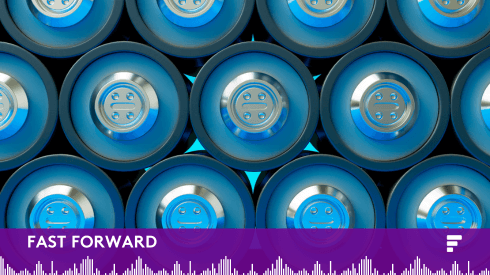By Jessica Long and Jingtai Lun
Vanadium’s ability to exist in a solution in four different oxidation states allows for a battery with a single electroactive element.
And compared with lithium batteries, which can spontaneously combust, vanadium redox flow batteries are prevented from exploding by their water-based electrolytes.
Vanadium battery capacity can also be expanded by increasing the number of vanadium electrolytes, making it safer for large-scale installation.
Given these advantages, the Chinese government sees the vanadium battery as an alternative to other, more hazardous storage batteries.
China’s national energy administration in June banned the use of ternary lithium batteries and sodium-sulphur batteries for energy storage due to safety issues. And the ministry of industry and information technology in August specifically mentioned vanadium redox flow batteries as part of its initiative to promote the development of mass energy storage.
“We constantly hear of cases of spontaneous combustion of lithium batteries, which account for almost 90% of battery energy storage explosions,” a vanadium market participant said.
China’s large vanadium reserves mean the country could be self-sufficient in producing vanadium batteries, as compared with the more common lithium battery, for which the country imports much of the raw material.
China has the world’s largest vanadium reserves, about 9.5 million tonnes at the end of 2021, according to the United States Geological Survey (USGS).
The soaring lithium market prices are also encouraging China to seek more reliable and cheaper alternatives.
Fierce competition among battery producers for global lithium resources sent Fastmarkets’ assessment of the spodumene min 6% Li2O spot price, cif China to a record high of $7,800-8,000 per tonne on November 10, its highest since Fastmarkets started tracking the price in July 2017.
China has brought a few vanadium projects online in the past two years, including the world’s largest vanadium redox flow power storage project in the northern Chinese city of Dalian, which was connected to China’s power grid on October 30 this year, according to the Chinese Academy of Science. The 100 MW or 400 MWh station will help buffer the irregular output of renewable-based electricity, the academy said. And there are plans to expanded the capacity to 200MW or 800MWh.
Vanadium battery storage capacity is forecast to double in 2023 from an estimated capacity of 0.73GW this year, according to a vanadium battery whitepaper published by independent research institute EVTank. The capacity will further increase to 24GW by 2030, EVTank said.
Vanadium producers get involved
The vanadium battery prospects have encouraged major Chinese vanadium producers to take part in producing the battery.
China’s biggest vanadium producer, Panzhihua Iron and Steel Group, formed a joint venture in October with battery maker Dalian Rongke Energy Storage Group to build a 2,000-cubic-meter-per-year vanadium electrolyte factory in Sichuan.
Panzhihua Iron & Steel will supply 4,000 tonnes of vanadium pentoxide for the Sichuan project and other vanadium battery projects that Dalian Rongke is operating this year. The amount will increase to 10,000 tonnes and 20,000 tonnes in 2023 and 2024 respectively, a source close to the projects said.
Hebei Iron & Steel Group (HISG), the world’s second-largest vanadium producer, in July 2022 completed construction of a production line with a capacity of 1,000 tonnes per year of vanadium electrolytes. HISG plans to build a 50,000-cubic-meter-per-year electrolyte production line and a 300-MW-per-year vanadium battery factory between 2022 and 2025.
Longer service life comes with near-term costs
Despite the increased development and use of vanadium batteries, a few barriers may hinder its rapid expansion.
The expense of building a vanadium-based energy storage project is significantly more than the cost of building a lithium-based project, posing the foremost challenge for vanadium battery projects.
“Building a vanadium battery costs around 3,000-4,000 yuan per kWh, while building a lithium battery costs about 1,500 yuan per kWh,” a battery raw-material analyst told Fastmarkets
Higher maintenance and lower energy efficiency are also drawbacks for the battery. Ambient temperature must be strictly controlled to ensure smooth operation of the battery. And the energy-to-volume ratio for vanadium batteries is around 70-75% of that for lithium batteries.
Vanadium batteries are nevertheless more cost efficient in the long run, considering their longer life cycle compared with other storage batteries.
“A lithium battery can normally work for around 10 years, but a vanadium battery can run for 20-30 years,” the battery raw-material analyst said.
If calculated for the whole life cycle, the cost of a vanadium battery is 300-400 yuan per kWh, compared with that of a lithium battery, which is about 500 yuan per kWh, a vanadium trader source told Fastmarkets.
Limited penetration
Even with the current expansion, vanadium batteries will continue to represent a much smaller proportion of energy storage than lithium batteries.
Lithium batteries accounted for 89.6% of the total installed energy storage capacity in 2021, research by the China Energy Storage Alliance shows. And the penetration rate of the vanadium redox flow battery in energy storage only reached 0.9% in the same year.
“The penetration rate of the vanadium battery may increase to 5% by 2025 and 10% by 2030, but the majority will still be lithium batteries,” the battery raw-material analyst said.
Steel-making will remain the main use for vanadium, the analyst said. Currently, more than 90% of vanadium is used in making steel, he said.
But sluggish demand from steel mills has lowered the spot price of vanadium pentoxide 98% V2O5 min, exw China in the past two weeks. Fastmarkets’ latest price assessment was 119,000-121,000 yuan per tonne ($16,616-16,895 per tonne) on November 17, down from 120,000-121,000 yuan per tonne on November 10.






